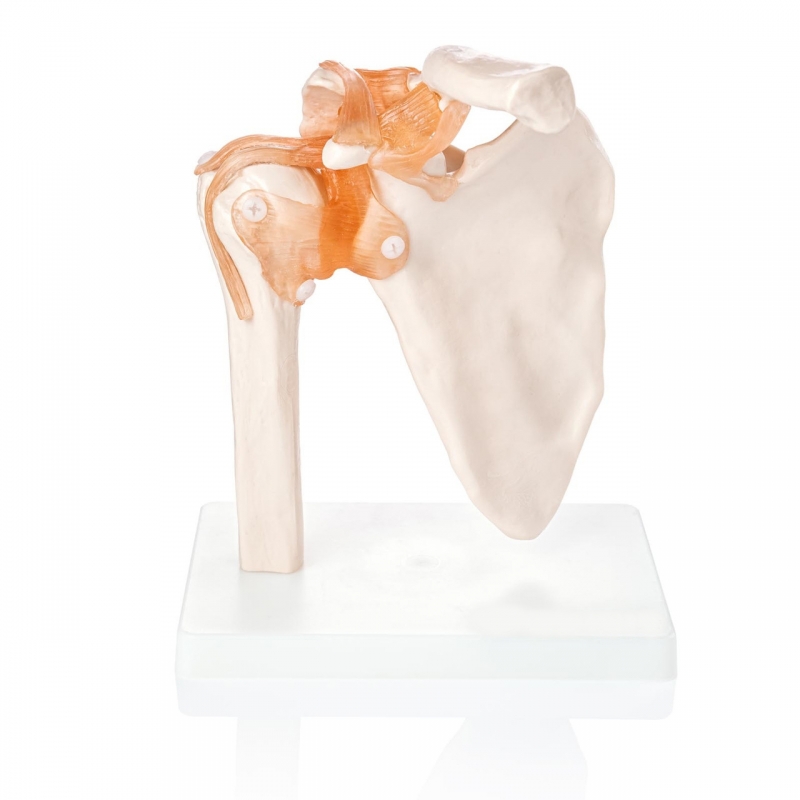
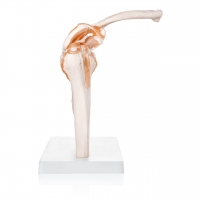
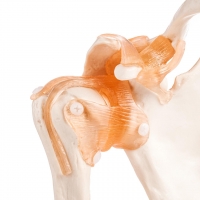
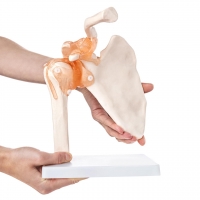
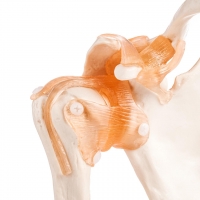





When it comes to joint mechanics, the shoulder is both the most mobile and most vulnerable. Understanding its complexity—bones, ligaments, and range of motion—is critical for anyone in orthopedics, sports therapy, physiotherapy, or anatomy education. The Human Shoulder Joint Model with Flexible Ligaments delivers that clarity with professional-grade precision.
Cast from an original human specimen, this model features the scapula, clavicle, humeral head, acromion, and ligaments with anatomical fidelity. Its standout feature? The flexible ligaments that demonstrate real shoulder movement—flexion, extension, abduction, adduction, and rotation—exactly how the joint behaves in real life.
Mounted on a stable base and measuring approximately 8.7 inches in height, the shoulder model is compact enough for a desk, yet detailed enough for demonstrations. It’s used across medical schools, rehabilitation centers, surgical education labs, chiropractic offices, and physiotherapy classrooms.
A common question: “Can it demonstrate injury mechanics or treatment rationale?” Absolutely. You can illustrate conditions such as rotator cuff tears, ligament sprains, dislocations, and impingement syndromes—making this model ideal for both clinician-patient communication and student training.
Search phrases like “shoulder joint model with ligaments,” “orthopedic shoulder anatomy teaching tool,” “PVC shoulder replica,” and “functional shoulder model” consistently lead to products like this—where form meets movement and theory meets application.
“I’ve used many shoulder models over the years, but this one is ideal for both function and structure. It’s made my teaching more visual and engaging,” says Dr. Anna G., Orthopedic Educator, Munich.
Made of non-toxic, medical-grade PVC, the model is lightweight, durable, and easy to clean. Whether you’re teaching in a classroom or explaining recovery exercises in a clinic, this is a model that earns its place—clearly, quietly, and consistently.
The MYASKRO Human Shoulder Joint Model isn’t just a visual tool—it’s a hands-on teaching instrument designed to move like the real thing. With flexible synthetic ligaments mimicking the natural tension and range of the shoulder joint, it allows for a complete demonstration of anatomical motion—making it ideal for dynamic learning environments.
All the major bones are present: scapula, clavicle, humerus—each molded in true-to-life proportion from a real specimen. The acromion process and coracoid structure are fully integrated, and the humeral head sits properly in the glenoid cavity, ensuring anatomical correctness at every angle. Movements like internal/external rotation, abduction, and circumduction can be clearly demonstrated, which is especially useful for sports medicine, kinesiology, and orthopedic rehabilitation.
Professionals often ask: “Can I show ligament injuries or impingement?” Yes. This model gives you the ability to demonstrate how ligament stress, poor biomechanics, or repetitive strain lead to real-world conditions like frozen shoulder, labrum tears, or rotator cuff dysfunctions. It’s one of the few models that moves enough to explain these subtle yet significant injury patterns.
Medical trainers love it for OSCEs, physical therapy skill labs, and surgical prep sessions. Chiropractors use it to explain joint misalignment or posture-related shoulder pain. And sports trainers use it to walk athletes through functional mobility and injury prevention.
The PVC construction ensures durability and safety. It’s easy to sanitize between uses, resists wear even with repeated motion demonstrations, and holds up under the demands of busy educational environments. The removable base mount allows you to take it off the stand for close-up interaction—perfect for one-on-one patient education or tabletop tutorials.
Keywords that align with this product include “functional shoulder joint replica,” “shoulder ligament anatomy model,” “orthopedic training shoulder,” and “rotator cuff movement demo tool.” It’s optimized for clinical practicality and search visibility alike.
“This model has changed how I explain injuries to patients. The ligaments move just enough to make the mechanics clear,” shares Dr. Michael T., Sports Chiropractor, Vancouver.
It’s rare to find a shoulder model that moves, teaches, and holds up over time—but this one checks every box.
Whether you're teaching shoulder anatomy to students or explaining mobility issues to patients, the Human Shoulder Joint Model with Flexible Ligaments offers more than a static reference—it delivers functional clarity. Every visible ligament and every natural movement reinforces the mechanical truth behind this highly mobile joint.
Shoulder instability, limited ROM, impingement, and chronic overuse injuries become easier to visualize and explain. From rotator cuff mechanics to acromioclavicular joint strain, the model brings discussions to life with anatomical accuracy and subtle motion that mirrors real joint behavior.
Its versatility makes it invaluable across multiple fields. Use it in medical training seminars, orthopedic diagnostics, rehabilitation programs, or sports performance assessments. The flexible ligaments help illustrate tension, restriction, and movement patterns in a way that 2D visuals or fixed bone models simply can’t match.
Another key question: “Does it suit remote or on-the-go teaching?” Yes. At just under 9 inches tall and mounted on a removable base, this model is both portable and presentation-ready. You can easily bring it into client consultations, training workshops, or university classrooms without sacrificing professionalism or detail.
Durability isn’t an afterthought—it’s built into the design. The medical-grade PVC skeleton and reinforced ligament attachments mean this model is engineered to last, even with daily handling. It’s as much a tool for long-term education as it is for first-day instruction.
This model aligns with high-intent search terms like “functional shoulder anatomy model,” “teaching model with ligaments,” “orthopedic shoulder joint replica,” and “movement-based shoulder demo tool.” Because what users search for is what this product delivers—realistic structure, soft tissue detail, and mechanical insight.
“The combination of anatomical detail and flexibility makes it the best shoulder model we’ve used. It bridges the gap between theory and movement beautifully,” says Nisha S., Physical Therapy Instructor, Mumbai.
Great teaching starts with great tools—and this shoulder joint model is exactly that. It’s not flashy. It’s not gimmicky. It’s simply effective—day in and day out, helping people see how the shoulder really works and why it sometimes doesn’t.
Total Reviews (0)